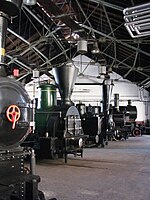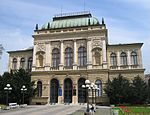Ljubljana Mosque
2020 establishments in SloveniaBežigrad DistrictBuildings and structures in LjubljanaMosques completed in 2020Mosques in Slovenia ... and 1 more
Religion in Ljubljana

The Islamic Religio-Cultural Center (Slovene: Islamski versko-kulturni center), colloquially known as the Ljubljana mosque (Džamija v Ljubljani or Ljubljanska mošeja) is an Islamic mosque and cultural-center complex in the Bežigrad district of Ljubljana, the capital of Slovenia. It is the culmination of a decades-long effort by the Islamic Community of Slovenia. A library, a classroom, an ablution fountain and the Imam's offices and quarters are included in the complex.
Excerpt from the Wikipedia article Ljubljana Mosque (License: CC BY-SA 3.0, Authors, Images).Ljubljana Mosque
Kurilniška ulica, Ljubljana Bežigrad
Geographical coordinates (GPS) Address Nearby Places Show on map
Geographical coordinates (GPS)
| Latitude | Longitude |
|---|---|
| N 46.060069444444 ° | E 14.502886111111 ° |
Address
Kurilniška ulica 10
1000 Ljubljana, Bežigrad
Slovenia
Open on Google Maps









